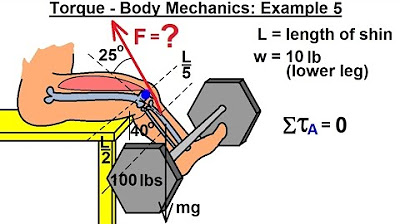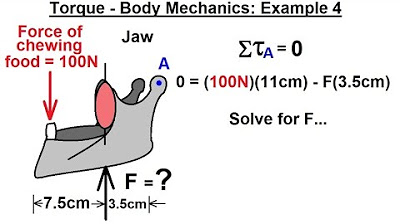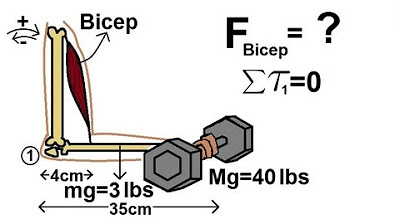Physics 15 Torque (18 of 25) Body Mechanics: Ex. 6, F=? on Back Muscle
TLDRThe video script illustrates the importance of proper body mechanics when lifting heavy objects. It explains the concept using a hypothetical scenario where a person is bending over with a weight, highlighting the significant force exerted by the back muscles to maintain equilibrium. The script calculates the force required to keep the body balanced in this position, factoring in the weight of the torso, the additional weight being held, and the weight of the head. It emphasizes that even without any extra weight, the body's position puts an enormous strain on the back, which is why it's advised to keep the back straight to reduce torque and prevent injury. The final calculation reveals that the back muscle force needed is approximately 5,555 Newtons, or roughly 1,250 pounds, underscoring the immense strength required and the risks involved in improper lifting techniques.
Takeaways
- 🚫 **Incorrect Lifting Posture**: Bending over with a heavy weight is not recommended due to the immense strain it places on the back muscles.
- 🏋️♂️ **Body Mechanics Importance**: Understanding body mechanics is crucial for safe lifting and preventing back injuries.
- 🎚️ **Force Distribution**: The force exerted by the back muscles is calculated based on the weight of the body parts and their distances from the pivot point.
- 🧮 **Calculating Torque**: Torque, the rotational force, is calculated by multiplying the force by the perpendicular distance from the force's line of action to the pivot point.
- ⚖️ **Equilibrium Equation**: The sum of all torques acting on the body must equal zero for the body to be in equilibrium.
- 📐 **Geometry of Lifting**: The script uses a triangle to determine the perpendicular distance (D) from the line of action of the force to the pivot point.
- 📉 **Reducing Torque by Positioning**: Keeping the back straight reduces the torque angle, allowing for safer and more effective weight lifting.
- 💪 **Muscle Strength Required**: The back muscle must exert a significant force to maintain equilibrium in a bent-over position, which is calculated to be 5,555 Newtons or approximately 1,250 pounds.
- 🤔 **Consideration of Head Weight**: The weight of the head, estimated to be around 100 Newtons, is factored into the overall force calculation.
- 📏 **Length of the Back as a Reference**: The length of the back (L) is used as a reference to calculate the distances of various body parts' weights from the pivot point.
- ⏏️ **Avoiding Back Injury**: The advice to keep the back straight when lifting is reinforced by the high force required to lift in a bent position, highlighting the risk of back injury.
Q & A
What is the main topic discussed in the provided transcript?
-The main topic discussed in the transcript is body mechanics, specifically focusing on the muscles in the back and the proper way to lift heavy weights to avoid injury.
Why is it not recommended to lift heavy weights with the back in a certain position?
-Lifting heavy weights with the back in a certain position is not recommended because it puts an enormous amount of force on the back muscles, which can lead to injury.
What is the approximate weight of the upper part of the body in Newtons?
-The approximate weight of the upper part of the body is about 300 Newtons.
How is the weight of the head estimated in Newtons?
-The weight of the head is estimated to be around 100 Newtons, which is equivalent to approximately 5 pounds.
What is the significance of the pivot point in the context of the force applied by the back muscles?
-The pivot point is significant because it is the point around which the torque is calculated. The force applied by the back muscles must counteract the torque from the weight of the body and any additional weight being lifted to maintain equilibrium.
What is the role of the back muscle in holding the body up when lifting a weight?
-The back muscle, specifically the one attached about 2/3 of the distance from the pivot point to the attachment on the back, is responsible for holding the body up when lifting a weight.
How is the force required by the back muscle to keep the body in equilibrium calculated?
-The force required by the back muscle is calculated by setting the sum of all torques acting on the body to zero, considering the weight of the torso, the weight being held, and the weight of the head, and then solving for the unknown force.
What is the approximate force in Newtons that the back muscle needs to apply to keep the body in equilibrium?
-The approximate force that the back muscle needs to apply is 5,555 Newtons.
How is the force in Newtons converted to pounds?
-The force in Newtons is converted to pounds by dividing by 4.44, since 1 pound is approximately equal to 4.44 Newtons.
What is the advice given to prevent back injuries when lifting weights?
-The advice given is to keep the back straight, which reduces the torque angle and allows for better lifting mechanics, thus reducing the risk of back injury.
Why is it important to consider the torque and force when lifting weights?
-Considering the torque and force is important because it helps to understand the physical demands on the body and to ensure that lifting is done in a way that minimizes the risk of injury.
What is the significance of the angle in the calculation of the force applied by the back muscle?
-The angle is significant because it determines the perpendicular distance (D) from the line of action of the force to the pivot point, which is a factor in the torque calculation and thus affects the force required by the back muscle.
Outlines
🏋️♂️ Understanding Back Muscle Mechanics in Lifting
This paragraph discusses the mechanics of the back muscles when lifting weights. It emphasizes the incorrectness of bending over while lifting and the importance of maintaining an upright back to reduce the torque on the spine. The speaker uses a simplified illustration to explain the forces at play, including the weight of the upper body, the head, and the force required from the back muscles to maintain equilibrium. Mathematical calculations are provided to determine the force needed by the back muscles, considering the weight of the body and the distances from the pivot point. The explanation concludes with a formula that incorporates the sine of a 12-degree angle to find the perpendicular distance from the line of action of the force to the pivot point.
🚫 The Risks of Poor Lifting Technique
The second paragraph calculates the force exerted by the back muscles when lifting in a poor posture. It demonstrates that even without adding extra weight, the body's position itself places a significant strain on the back. The speaker calculates the force required in newtons and then converts it to pounds to highlight the substantial strength needed to hold the body up in such a position. The paragraph concludes with advice to keep the back straight while lifting to reduce the risk of injury, as poor lifting technique can lead to back problems.
Mindmap
Keywords
💡Body Mechanics
💡Back Muscles
💡Bending Over
💡Weights
💡Newtons
💡Torque
💡Equilibrium
💡Pivot Point
💡Force Application
💡Straight Back Position
💡Injury Prevention
Highlights
The importance of proper body mechanics when lifting heavy weights is emphasized to prevent back injuries.
An example is given where a person is bending over and holding a weight, which is not recommended due to the strain on the back muscles.
The concept of torque and its role in body mechanics is introduced, explaining how the sum of torques must equal zero for equilibrium.
A mathematical model is used to calculate the force required for a back muscle to hold the body up in a bent position.
The weight of the body's upper part and head are considered in the calculation, with the head's weight estimated at 100 Newtons.
The force exerted by the back muscle is calculated using the sine of the angle between the muscle's line of action and the pivot point.
A triangle is used to visualize and solve for the perpendicular distance (D) from the force's line of action to the pivot point.
The final calculation reveals that the back muscle needs to exert a force of 5,555 Newtons, which is equivalent to approximately 1,250 pounds.
The transcript highlights the enormous amount of force required to hold the body in a bent position, even without additional weight.
The advice to keep the back straight is given to reduce the torque angle, making it easier and safer to lift weights.
The potential for back injury from improper lifting techniques is discussed, stressing the need for correct body mechanics.
The concept of the pivot point in body mechanics and its significance in maintaining equilibrium is explained.
A step-by-step mathematical approach is used to understand the forces involved in lifting, providing a practical application of physics to everyday activities.
The illustration of the person's body with labels for legs, back, arms, and head helps visualize the forces acting on the body during lifting.
The significance of the muscle's attachment point to the pivot point is discussed in relation to the force it needs to apply.
The transcript provides a clear demonstration of how improper lifting techniques can lead to back injuries due to the high forces involved.
The conversion of Newtons to pounds is done to cater to an audience that may be more familiar with the pound measurement of force.
The transcript concludes with a strong recommendation against lifting in a bent-over position due to the significant risk of back injury.
Transcripts
Browse More Related Video

Physics 15 Torque (17 of 25) Body Mechanics: Ex. 5, F=? Leg Lifting Weights

Physics 15 Torque (13 of 27) Body Mechanics: Ex. 1, F=? To Lift Up Arm

Physics 15 Torque (14 of 27) Body Mechanics: Ex. 2, F=? To Lift Dumbbell

Physics 15 Torque (16 of 25) Body Mechanics: Ex. 4, F=? Jaw Muscle

Physics 15 Torque Example 5 (5 of 7) The Bicep

Physics 15 Torque (20 of 25) More Examples: 2 F=? of Screw on Bracket
5.0 / 5 (0 votes)
Thanks for rating: